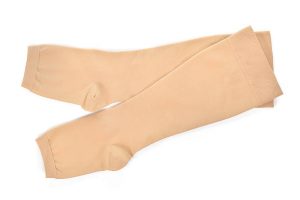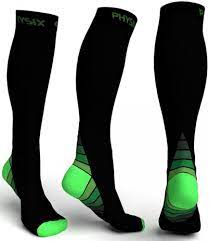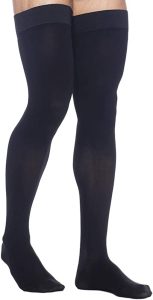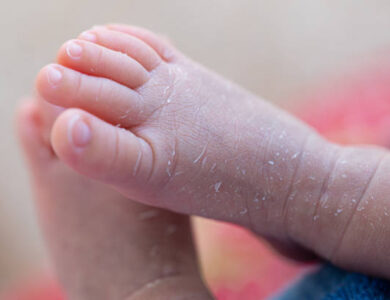Compression Socks – 7 Best (Ankle, Thigh-high) for Athletes, Travellers & More

Compression socks have become increasingly popular in recent years as more and more men are discovering the benefits of wearing these specialized socks.
In fact, the compression socks market in the United States is expected to reach $3.5 billion by 2027. Furthermore, research shows that men are more likely than women to use them for athletic performance and recovery.
With so many options available, it can be challenging to find the right pair of compression socks to meet your needs.
To help you out, we’ve put together a list of the 7 best compression socks for different categories of people, including ankle-high and thigh-high options.
So, as an athlete, a frequent traveller, or just looking to improve your leg health, these compression socks are sure to be a game-changer.
Table of Contents
Quick Overview of the Best Compression Socks
- Best Ankle High Compression Socks: SB SOX Compression Ankle Brace
- Best Thigh High: Sigvaris Men’s Access Thigh High Compression Stockings
- Best for Athletes and Runners: CEP Progressive+ Compression Socks
- Best for Frequent Travellers: Physix Gear Sport Compression Socks
- Best for Medical Purposes: SB SOX compression socks
What level of compression socks do I need?
| Compression Level | Amount of Pressure (mmHg) | Best for |
|---|---|---|
| Mild compression | 8-15 | Mild swelling, fatigue, and discomfort; preventive measure for those at risk of circulatory problems |
| Moderate compression | 15-20 | Mild to moderate swelling, varicose veins, and other circulatory problems; preventive measure for those at higher risk |
| Firm compression | 20-30 | Moderate to severe swelling, varicose veins, and other circulatory problems; prevention of blood clots in high-risk individuals |
| Extra-firm compression | 30-40 | Severe swelling, varicose veins, advanced circulatory problems, and lymphedema |
What happens when you start wearing compression socks? Benefits of Wearing Them
- Improved blood flow
- Reduced swelling in the legs, ankles, and feet.
- Improved athletic performance
- Reduced muscle soreness and inflammation after exercise or other physical activity.
- Improved recovery after surgery
- Relief for varicose veins
- Comfort and support
What are the disadvantages of using these socks?
While compression socks can provide many benefits, there are some potential disadvantages to consider as well.
Here are some of the most common disadvantages:
- Some people may find them uncomfortable to wear, especially if they are not the right size or level of compression.
- They may cause skin irritation or allergic reactions in some people, especially if they are worn for long periods of time.
- Are more expensive than regular socks, and they may need to be replaced more frequently if they lose their elasticity.
- They can be difficult to put on, especially for people with limited mobility or dexterity.
- As mentioned earlier, they may not be appropriate for individuals with certain conditions, such as PAD or congestive heart failure.
Types of Compression Socks

- Ankle-high: These socks provide compression from the ankle up to the lower calf. They are ideal for people who are on their feet for long periods or who experience mild swelling or discomfort in the lower legs.
- Knee-high compression socks: These socks provide compression from the ankle up to the knee. They are the most common type of compression socks and are suitable for a range of conditions, including varicose veins, deep vein thrombosis, and lymphedema.
- Thigh-high: These socks provide compression from the ankle all the way up to the thigh. They are often recommended for people with more severe swelling or circulation issues.
- Compression stockings: These are similar to thigh-high compression socks but are made with stronger, medical-grade compression. They are often used to treat more severe conditions such as chronic venous insufficiency or post-thrombotic syndrome.
- Athletic compression socks: These socks are designed specifically for athletes and provide targeted compression to improve performance and aid in recovery. They are often made with moisture-wicking materials and may have extra padding in key areas.
- Maternity compression socks: These socks are designed for pregnant women to help reduce swelling and discomfort in the legs and feet.
- Anti-embolism compression socks: These socks are designed for people who are at high risk of developing blood clots, such as those who have recently had surgery or who are immobile for extended periods. They provide graduated compression to improve blood flow and reduce the risk of clot formation.
Best Ankle High Compression Socks
SB SOX Compression Ankle Brace ( Best Overall Compression socks for medical purposes)

This ankle-high compression sock provides targeted support to the ankle joint and foot arch. It features graduated compression technology that helps to improve blood flow, reduce swelling, and alleviate pain and discomfort.
The SB SOX Compression Ankle Brace is a breathable, moisture-wicking fabric that keeps your feet dry and comfortable. It is also designed to stay in place without slipping or bunching up.
Pros
- The targeted compression provided by the ankle brace helps to reduce swelling and inflammation and promote blood circulation.
- The seamless 3D circular knit technology ensures a comfortable and secure fit, and helps to prevent skin irritation and chafing.
- The breathable and moisture-wicking material keeps the skin dry and cool, even during extended wear.
- The non-slip cuff ensures that the ankle brace stays securely in place without slipping or bunching up.
- The ankle brace is lightweight and can be worn comfortably under socks and shoes.
Cons:
- Some users may find the compression to be too tight, especially if they have sensitive skin or a larger ankle size.
- The ankle brace may not provide enough support for more severe ankle injuries or conditions.
- The non-slip cuff may cause discomfort or irritation for some users, especially if worn for extended periods of time.
Physix Gear Sport Compression Socks

These ankle-high compression socks are designed to provide optimal support and comfort during sports activities or everyday wear. They feature a reinforced heel and toe area, as well as a snug fit that prevents slippage and bunching up.
The Physix Gear Sport Compression Socks also utilize graduated compression technology that helps to reduce swelling, improve blood flow, and prevent fatigue and soreness in the feet and legs.
They are made of a high-quality, durable fabric that is breathable, moisture-wicking, and odour-resistant.
Pros:
- The Physix Gear Sport Compression Socks provide graduated compression that helps to improve blood flow, reduce muscle vibration, and prevent fatigue and soreness.
- The socks are made of a high-quality, moisture-wicking material that keeps your feet dry and comfortable.
- They feature a non-slip cuff that keeps them securely in place without causing irritation or discomfort.
- The socks come in a variety of colours and styles, making them a fashionable choice for athletes and runners.
- They are designed to provide optimal support and relief to the legs during sports activities and other physical activities.
Cons:
- Difficult to put on and take off, especially for those with limited mobility.
- A bit costly
Thigh High Compression Socks
Sigvaris Men’s Access Thigh High Compression Stockings

These compression socks are designed to provide optimal support and relief to the legs. They feature graduated compression technology that improves blood circulation, reduces swelling, and prevents fatigue and soreness.
The Sigvaris Men’s Access Thigh High Compression Stockings are breathable, moisture-wicking fabric that keeps your skin dry and comfortable. They also have a silicone grip top band that keeps them in place without slipping or causing irritation.
Pros:
- The Sigvaris brand is well-known for its quality compression garments, and the Men’s Access Thigh High Stockings are designed specifically for men’s needs.
- The stockings come in a range of sizes to ensure a comfortable and effective fit.
- They are made with a durable and breathable fabric that is designed to last through multiple wears and washes.
Cons:
- none
JOBST Relief Thigh High Compression Stockings
These compression socks are known for their superior comfort and effectiveness.
They provide graduated compression that helps to reduce swelling, improve blood flow, and prevent fatigue and soreness. The JOBST Relief Thigh High Compression Stockings are made of a soft and durable material that feels comfortable against the skin.
They also feature a silicone dot top band that keeps them securely in place without causing irritation or discomfort.
Pros:
- The JOBST brand is well-known for its quality compression garments, and the Relief Thigh High Stockings are designed to provide comfortable and effective compression for a range of conditions.
- The stockings are available in a variety of compression levels and sizes to suit individual needs.
- They are made with a soft and breathable fabric that is designed to provide all-day comfort.
Cons:
- Some people may find the thigh-high style to be too restrictive or uncomfortable or may have trouble keeping the stockings in place throughout the day.
Best Compression Socks for Athletes and Runners
CEP Progressive+ Compression Socks
These compression socks are designed specifically for athletes and runners. They provide graduated compression that helps to improve blood flow, reduce muscle vibration, and prevent fatigue and soreness.
The CEP Progressive+ Compression Socks are made of a high-quality, moisture-wicking material that keeps your feet dry and comfortable. They also feature a padded footbed, which provides additional cushioning and support.
These compression socks are highly recommended by athletes and runners for their effectiveness and comfort.
Pros:
- The CEP brand is well-known for its quality compression garments, and the Progressive+ Compression Socks are designed to provide targeted compression for different areas of the foot and calf.
- The socks are made with a breathable and moisture-wicking fabric that helps keep feet dry and comfortable.
- They come in a variety of colours and styles to suit individual preferences.
Cons:
- A bit costly
Zensah Tech+ Compression Socks
These compression socks are designed to provide optimal support and relief to the legs during sports activities. They feature targeted compression zones that help to improve blood flow, reduce muscle fatigue, and prevent injuries.
The Zensah Tech+ Compression Socks are breathable and moisture-wicking material that keeps your feet dry and comfortable.
They also have a seamless toe design that prevents irritation and chafing. These compression socks are highly recommended by athletes and runners for their superior performance and comfort.
Pros:
- The Zensah brand is well-known for its quality compression garments, and the Tech+ Compression Socks are designed to provide targeted compression for different areas of the foot and calf.
- The socks are made with a soft and breathable fabric that helps prevent blisters and chafing and are available in a variety of colours and styles to suit individual preferences.
- They come with a seamless toe design and a reinforced heel and toe for added durability.
Cons:
- A bit costly
Best Compression Socks for Frequent Travellers
Physix Gear Sport Compression Socks
These compression socks are ideal for frequent travellers who want to prevent swelling and discomfort in their legs. They feature graduated compression technology that improves blood circulation, reduces swelling, and prevents fatigue and soreness. The Physix Gear Sport Compression Socks are made of a high-quality, breathable material that wicks away moisture and keeps your feet dry and comfortable. They also feature a non-slip cuff that keeps them securely in place without causing irritation or discomfort.
Pros:
- The Physix Gear Sport brand is well-known for its quality compression garments, and the Compression Socks are designed to provide targeted compression for different areas of the foot and calf.
- The socks are made with a breathable and moisture-wicking fabric that helps keep feet dry and comfortable and are available in a variety of colours and styles to suit individual preferences.
- They come with a reinforced heel and toe for added durability, and a non-slip cuff to keep them in place.
Cons:
- A bit costly
Why do nurses wear compression socks?
Nurses often wear compression socks because they spend long hours on their feet and are at risk for leg fatigue, swelling, and circulatory issues.
Nurses may also wear them to reduce the risk of developing varicose veins, which can be a common problem for people who spend a lot of time standing or sitting.
Varicose veins can cause pain, swelling, and aching, and may require medical treatment in more severe cases.
How many hours a day should I wear compression socks?
The length of time you should wear them each day can vary depending on your individual needs and the reason you are wearing them. It’s best to follow the advice of your healthcare provider or the manufacturer’s instructions for your specific socks.
For mild swelling or discomfort, you may be advised to wear compression socks for a few hours each day or as needed. If you have a more severe condition, such as chronic venous insufficiency or lymphedema, you may need to wear compression socks for longer periods, such as throughout the day and night.
If you are wearing these for athletic performance or recovery, you may wear them for a shorter period, such as during exercise or for a few hours afterwards.
Wearing compression socks for too long or wearing socks that are too tight can actually cause more harm than good.
Who should not wear compression socks?
While they are generally safe for most people, there are some cases where they may not be recommended or suitable.
These individuals should consult with a healthcare provider before wearing compression socks:
- People with peripheral artery disease (PAD)
- People with skin infections or allergies.
- People with cancer that affects the lymphatic system, such as lymphoma.
- People with congestive heart failure (CHF).
- People with diabetes.
Should compression socks be tight or loose on the feet?
They should be snug but not excessively tight and should be removed at least once a day especially if you are a gardener who kneels a lot without using good kneeler workbenches that will allow for blood circulation on ankles and knees.
Why do my legs hurt when I wear compression socks?
Here are some possible reasons why your legs may hurt when wearing them:
- Poor fit: too tight or too loose may cause discomfort, pain, or even swelling. It’s important to make sure you are wearing the correct size and level of compression for your needs.
- Allergic reaction: Some people may have an allergic reaction to the material used in making them, which can cause itching, redness, or pain.
- Pressure points: If not worn evenly or if they are bunching up in certain areas, they may create pressure points that cause pain or discomfort.
- Underlying medical conditions: In some cases, leg pain may be a symptom of an underlying medical condition, such as PAD, deep vein thrombosis (DVT), or arthritis.
- Overuse: Wearing them for too long or too frequently may cause leg pain or discomfort, especially if you are not used to wearing them.
Do compression socks raise BP?
There is no evidence to suggest that they raise blood pressure (BP). In fact, these socks are often recommended as a way to improve circulation and lower blood pressure in individuals with hypertension or other circulatory problems.
Compression socks work by applying graduated pressure to the legs, which helps to improve blood flow and prevent blood from pooling in the lower extremities.
This increased circulation can actually help to lower blood pressure and reduce the risk of complications such as blood clots or deep vein thrombosis (DVT).
How do I know if compression socks are working?
Here are signs that your socks are working for you:
- Reduced swelling
- Improved comfort
- Improved circulation: If you have circulation problems, you may notice that your legs feel less tired or heavy after wearing compression socks for a period of time.
- Improved performance: Athletes or active individuals may notice improved performance or less muscle soreness after wearing compression socks during exercise or physical activity.
How long does it take for compression socks to work?
The amount of time it takes for compression socks to work can vary depending on the individual and their specific condition. In general, some people may notice immediate relief from symptoms such as swelling or discomfort, while others may take longer to experience the full benefits of compression socks.
Is it OK to sleep in compression socks?
It is not recommended to sleep in compression socks unless specifically instructed to do so by a healthcare provider. While compression socks can be beneficial during waking hours for improving circulation, reducing swelling, and alleviating discomfort, there are potential risks associated with wearing them while sleeping.
Firstly, wearing compression socks while sleeping may cause discomfort or even pain, as the pressure can be more noticeable in a lying position.
Additionally, wearing compression socks for extended periods of time, including while sleeping, can increase the risk of skin irritation, skin breakdown, or other complications.
Can you wear compression stockings with an ulcer?
Yes, compression stockings can be worn with an ulcer as part of the treatment plan for venous ulcers.
Venous ulcers are often caused by poor circulation in the legs and can be treated with compression therapy to improve blood flow and promote healing.
Where does the fluid go when wearing compression stockings?
Compression stockings work by applying graduated pressure to the legs, which helps to improve blood flow and prevent fluid buildup in the tissues. The pressure from the stockings helps to push the blood and fluids up towards the heart, where they can be more effectively circulated and eliminated from the body.
As the blood and fluids are moved up the leg, the compression stockings also help to prevent them from pooling in the ankles and feet, which can lead to swelling and discomfort. Instead, the fluids are directed towards the larger veins and lymphatic vessels, where they can be processed and eliminated through the body’s natural processes.




One Comment